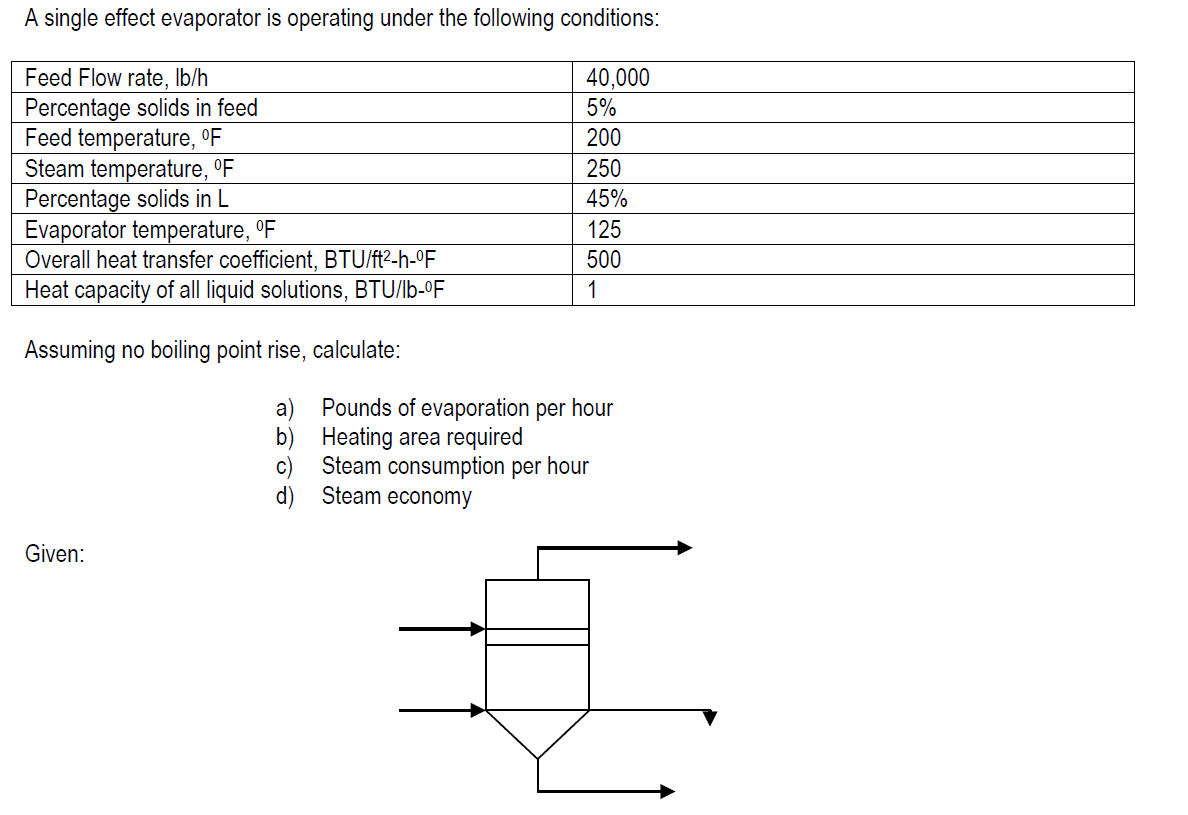A single effect evaporator is operating under the following conditions: Feed Flow rate, lb/h Percentage solids in feed Feed temperature, °F Steam temperature, °F Percentage solids in L Evaporator temperature, ºF Overall heat transfer coefficient, BTU/ft²-h-ºF Heat capacity of all liquid solutions, BTU/lb-ºF Assuming no boiling point rise, calculate: Given: 40,000 5% 200 250 45% C) d) 125 500 1 a) Pounds of evaporation per hour Heating area required b) Steam consumption per hour Steam economy
A single effect evaporator is operating under the following conditions: Feed Flow rate, lb/h Percentage solids in feed Feed temperature, °F Steam temperature, °F Percentage solids in L Evaporator temperature, ºF Overall heat transfer coefficient, BTU/ft²-h-ºF Heat capacity of all liquid solutions, BTU/lb-ºF Assuming no boiling point rise, calculate: Given: 40,000 5% 200 250 45% C) d) 125 500 1 a) Pounds of evaporation per hour Heating area required b) Steam consumption per hour Steam economy
Introduction to Chemical Engineering Thermodynamics
8th Edition
ISBN:9781259696527
Author:J.M. Smith Termodinamica en ingenieria quimica, Hendrick C Van Ness, Michael Abbott, Mark Swihart
Publisher:J.M. Smith Termodinamica en ingenieria quimica, Hendrick C Van Ness, Michael Abbott, Mark Swihart
Chapter1: Introduction
Section: Chapter Questions
Problem 1.1P
Related questions
Question
Solution:
1. Use the Solute Balance to calculate for the liquid product L
2. Use the overall mass balance to calculate for the vapor product V
3. Calculate for the enthalpy of the feed hF and the enthalpy of the liquid product hL using the h = cPdT. Use a datum temperature T = ____________.

Transcribed Image Text:A single effect evaporator is operating under the following conditions:
Feed Flow rate, Ib/h
Percentage solids in feed
Feed temperature, ºF
Steam temperature, °F
Percentage solids in L
Evaporator temperature, OF
Overall heat transfer coefficient, BTU/ft²-h-ºF
Heat capacity of all liquid solutions, BTU/lb-OF
40,000
5%
200
250
45%
125
500
Assuming no boiling point rise, calculate:
Pounds of evaporation per hour
a)
b) Heating area required
Steam consumption per hour
c)
d) Steam economy
Given:
Expert Solution
This question has been solved!
Explore an expertly crafted, step-by-step solution for a thorough understanding of key concepts.
Step by step
Solved in 4 steps with 1 images

Recommended textbooks for you

Introduction to Chemical Engineering Thermodynami…
Chemical Engineering
ISBN:
9781259696527
Author:
J.M. Smith Termodinamica en ingenieria quimica, Hendrick C Van Ness, Michael Abbott, Mark Swihart
Publisher:
McGraw-Hill Education

Elementary Principles of Chemical Processes, Bind…
Chemical Engineering
ISBN:
9781118431221
Author:
Richard M. Felder, Ronald W. Rousseau, Lisa G. Bullard
Publisher:
WILEY

Elements of Chemical Reaction Engineering (5th Ed…
Chemical Engineering
ISBN:
9780133887518
Author:
H. Scott Fogler
Publisher:
Prentice Hall

Introduction to Chemical Engineering Thermodynami…
Chemical Engineering
ISBN:
9781259696527
Author:
J.M. Smith Termodinamica en ingenieria quimica, Hendrick C Van Ness, Michael Abbott, Mark Swihart
Publisher:
McGraw-Hill Education

Elementary Principles of Chemical Processes, Bind…
Chemical Engineering
ISBN:
9781118431221
Author:
Richard M. Felder, Ronald W. Rousseau, Lisa G. Bullard
Publisher:
WILEY

Elements of Chemical Reaction Engineering (5th Ed…
Chemical Engineering
ISBN:
9780133887518
Author:
H. Scott Fogler
Publisher:
Prentice Hall


Industrial Plastics: Theory and Applications
Chemical Engineering
ISBN:
9781285061238
Author:
Lokensgard, Erik
Publisher:
Delmar Cengage Learning

Unit Operations of Chemical Engineering
Chemical Engineering
ISBN:
9780072848236
Author:
Warren McCabe, Julian C. Smith, Peter Harriott
Publisher:
McGraw-Hill Companies, The